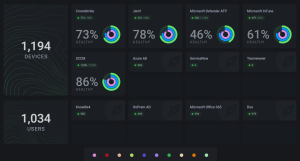In the fast-paced digital era where organizations heavily rely on technology, managing cyber assets has become a critical aspect of ensuring a secure and resilient digital landscape. Cyber Asset Management (CAM) plays a pivotal role in this realm, offering a structured approach to identify, track, and protect digital assets.

Understanding Cyber Asset Management
Cyber Asset Management involves the systematic organization, monitoring, and protection of an organization’s digital assets, ranging from hardware and software to data and networks. It goes beyond traditional IT asset management by incorporating a cybersecurity perspective, recognizing the evolving threats and vulnerabilities in the digital space.
4 Pillars of Cyber Asset Management
1. Cyber Asset Attack Surface Management
Automated discovery of your IT assets and validation of security control deployment, functionality, and compliance. These include but are not limited to Antivirus protection, Managed Defense, Patching, Device Encryption, Web Proxy, and Multi-factor Authentication (MFA).
2. Vulnerability Management
Identifying and addressing vulnerabilities in a timely manner is a key component of CAM. Regular vulnerability assessments help organizations stay ahead of potential threats, ensuring that security patches are applied promptly to mitigate risks.
3. Next Level Insights
Instantly see all your devices which are accessing corporate systems and the relevant asset information. You’ll be able to access asset detail manufacturer, model, warranty info, serial number, and other such details. You can filter this information by user, make, model or operating system and save these views for future reference.
4. Cyber Risk Reporting
A reporting engine allowing executives to effectively track and monitor cyber risks can provide insights that allow the business and IT to make the necessary decisions on investments related to cyber assets.

4 Benefits of Cyber Asset Management
1. Risk Mitigation
CAM enables organizations to proactively identify and mitigate cybersecurity risks, reducing the likelihood of security incidents and their associated consequences.
2. Cost Optimization
By optimizing the use of digital assets and streamlining processes, CAM contributes to cost savings and efficiency improvements.
3. Enhanced Security Posture
A well-implemented CAM strategy strengthens an organization’s overall security posture, instilling confidence among stakeholders and customers.
4. Regulatory Compliance
CAM ensures that organizations adhere to regulatory requirements, safeguarding them from legal and financial penalties associated with non-compliance.
In the ever-evolving landscape of cyber threats, Cyber Asset Management acts as a new standard of resilience, providing organizations with the tools and strategies needed to safeguard their digital assets. By adopting a holistic approach to asset management with a cybersecurity focus, your organization can navigate the complexities of the digital world with confidence, knowing that your critical assets are protected from potential threats.


